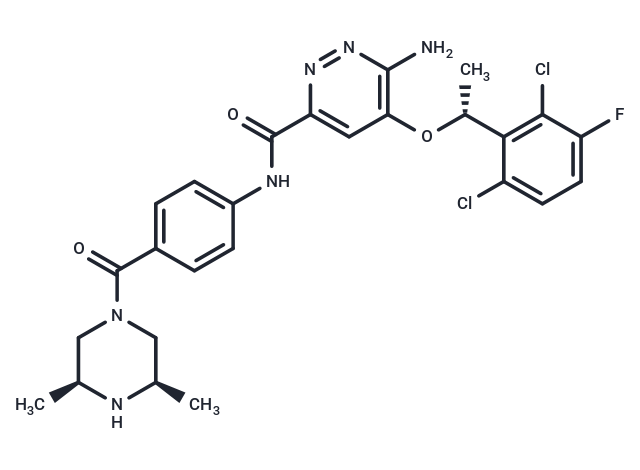Shopping Cart
- Remove All
 Your shopping cart is currently empty
Your shopping cart is currently empty

Ensartinib (X-396) is a potent dual ALK/MET inhibitor with IC50 values of <0.4 nM for ALK and 0.74 nM for MET.

| Pack Size | Price | Availability | Quantity |
|---|---|---|---|
| 25 mg | $1,820 | 1-2 weeks | |
| 50 mg | $2,380 | 1-2 weeks | |
| 100 mg | $3,100 | 1-2 weeks |
| Description | Ensartinib (X-396) is a potent dual ALK/MET inhibitor with IC50 values of <0.4 nM for ALK and 0.74 nM for MET. |
| Targets&IC50 | MET:0.74 nM (IC50) |
| In vitro | Ensartinib (X-396) has been evaluated for its efficacy in inhibiting the proliferation of various cancer cell lines characterized by ALK fusions or point mutations. It exhibits significant potency in H3122 lung cancer cells with EML4-ALK E13;A20 mutations (IC50: 15nM) and in H2228 lung cancer cells with EML4-ALK E6a/b; A20 mutations (IC50: 45 nM). Additionally, its efficacy extends to SUDHL-1 lymphoma cells containing NPM-ALK (IC50: 9 nM) and demonstrates inhibition in SY5Y neuroblastoma cells with ALK F1174L mutation, MKN-45 gastric carcinoma cells dependent on MET, HepG2 cells, and PC-9 lung cancer cell lines possessing EGFR exon 19 deletion, with IC50 values of 68 nM, 156 nM, 9.644 μM, and 2.989 μM, respectively. |
| In vivo | The in vivo effects of Ensartinib (X-396) against H3122 xenografts were studied, showing that Ensartinib exhibits considerable bioavailability and moderate in vivo half-lives. Treatment of nude mice bearing H3122 xenografts with 25mg/kg bid of Ensartinib markedly inhibited tumor growth compared to the control. Ensartinib was well-tolerated, with no significant impact on mouse weight or indications of toxicity. Additional studies in Sprague Dawley (SD) rats, involving repeated oral doses of Ensartinib (20, 40, 80 mg/kg) over 10 days, confirmed survival of all subjects till study end without significant toxicity; the no significant toxicity (NST) threshold was established at 80mg/kg. At this NST level, Ensartinib showed an AUC of 66 μM×hr and a peak concentration (Cmax) of 7.19 μM[1]. |
| Cell Research | For viability experiments, cells are seeded in 96-well plates at 25%-33% confluency and exposed to drugs.The human lung adenocarcinoma cell lines H3122 and H2228 are treated with Ensartinib (10, 30, 100, 300 and 1000 nM). SUDHL-1 lymphoma cells are treated with Ensartinib (5, 10, 30, 100 and 300 nM). SY5Y neuroblastoma cells are treated with Ensartinib (30, 100, 300 and 1000 nM). At 72 hours post Ensartinib addition, Cell Titer Blue Reagent is added and fluorescence is measured on a Spectramax spectrophotometer. All experimental points are set up in hextuplicate replicates and are performed at least two independent times. IC50s are calculated using GraphPad Prism version 5 for Windows. The curves are fit using a nonlinear regression model with a log (inhibitor) vs. response formula[1]. |
| Molecular Weight | 561.44 |
| Formula | C26H27Cl2FN6O3 |
| Cas No. | 1370651-20-9 |
| Relative Density. | no data available |
| Storage | Powder: -20°C for 3 years | In solvent: -80°C for 1 year | Shipping with blue ice. |
| Solubility Information | DMSO: Soluble |

Copyright © 2015-2025 TargetMol Chemicals Inc. All Rights Reserved.